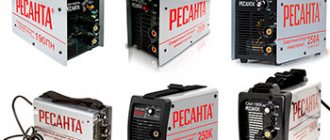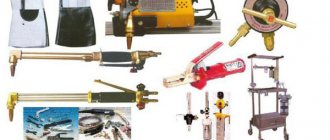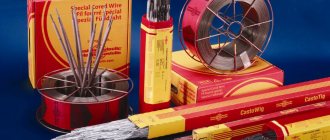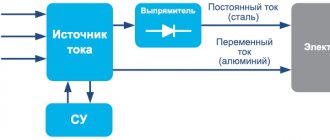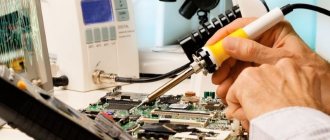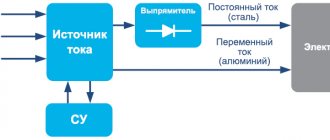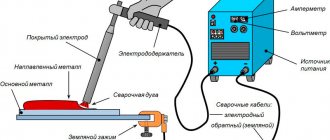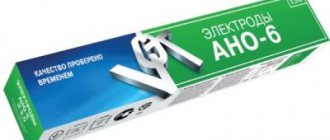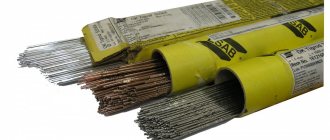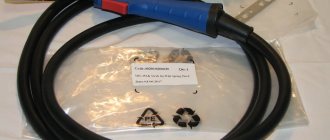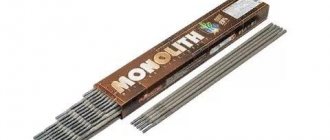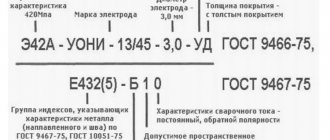A welding inverter is a welding device that currently occupies a leading position in popularity among welders, both experienced and beginners. These welding devices took all the best from transformers and received an additional number of useful options. Their popularity is justified by the possibility of universal use: from home to production.
Welding inverters appeared on the market in the 70s of the last century. They replaced transformers, although they never completely pushed them out of the market. The main features of these devices are compactness, ease of use and accessibility. These characteristics are important for those new to welding. Modern inverters have a number of useful functions that help you quickly master an activity such as welding.
In this article we will analyze in detail how to choose a welding inverter by type and characteristics, as well as the method for selecting a suitable unit.
Basic classification of inverters:
- Household - the most convenient option if you carry out welding work at home, outside the city, or in the garage. Devices in this category are perfect for novice welders. Welding current range: from 160 to 200 A.
- Professional – ideal for employees of small companies, car repair shops and private entrepreneurs. A well-chosen unit will increase the operating time under difficult external conditions. Welding current range: from 200 to 300 A.
- Industrial – used in production, welding shops and large-scale facilities. Inverters in this category allow large volumes to be welded continuously, ensuring the required standard of weld quality. Welding current range: from 250 to 500 A.
Which is better: a welding inverter or a transformer?
Of course, it is impossible to answer this question unambiguously. Everyone chooses based on the parameters they need. Therefore, for your convenience, we will provide a small comparison table.
| Comparison criteria / type of welding machine | Inverter | Transformer |
| Amount of electricity consumed | Several times less compared to a transformer. For example, when working with an electrode with a diameter of 3 mm, it consumes less than 4 kW. | Significantly drains the network. For example, when working with an electrode with a diameter of 3 mm, it consumes more than 6 kW. |
| Dimensions and transportation options | Weight is about 4 kg and small in size - convenient to hang on your shoulder and work. Easily move to the right place. | The weight and dimensions exceed the dimensions of the inverter by 2 times or more. Difficulties with transportation. |
| terms of Use | Particularly sensitive to dust and moisture content in the air, as well as to sub-zero temperatures. These factors can lead to rapid breakdown. | Able to work in almost any conditions. |
| Maintainability | Difficulties arise during repairs: if an IGBT module breaks down, purchasing a new one is 1/3 of the total cost of the inverter. | Easy to find parts and repair. |
| Duration of welding work | Avoid overheating of the equipment and give it time to cool down. | Continuous operation possible. |
| Resistance to voltage surges | Low. The arc does not burn stably, except for devices that are protected against changes in this network parameter. | The arc is resistant to voltage surges. Minimum amount of spatter is generated during welding. This is achieved thanks to a stable welding current, which is not affected by fluctuations in input voltage. |
| Additional functions | Hot Start guarantees stable arc ignition; Arc Force reduces the likelihood, and Antistick eliminates “sticking” of the electrode to the part. | No. |
| Price | High. | 2-3 times cheaper than an inverter device. |
Equipment and accessories
Depending on the specific equipment model, equipment may vary. However, there is a necessary minimum that must be present in each kit:
- welding machine;
- 2 welding cables (about 2 meters long);
- warranty passport;
- instructions for use.
The kit may also contain additional elements:
- welding mask;
- carrying case;
- carrying handles;
- shoulder straps;
- brush for cleaning equipment.
Accessories
To facilitate the work of the welder and subsequent maintenance of the equipment, there are various types of accessories that can be divided into several groups:
Electrodes for welding machine:
- for welding carbon and low-alloy steel;
- for surfacing;
- for welding cast iron;
- for welding non-ferrous metals;
- for cutting;
- for welding high-alloy steel;
- for welding alloyed heat-resistant steel;
- for welding dissimilar metals.
Sprays and pastes. The compositions are intended for different purposes:
- fire protection of surfaces located in close proximity to welding operations;
- protection against splash adhesion;
- non-stick protection for gas burners and others.
Supporting materials:
- welder's mirror;
- construction pencils and talc chalk holders;
- rulers and squares.
Accessories also include:
- Burners.
- Plasma cutters.
- Electric holders.
- Grounding clamps.
- Welding cables.
Useful features
Certain functions of these devices make them indispensable assistants for novice welders:
- Hot Start option – makes it easier to ignite the arc by increasing the current.
- Antistick option – prevents the electrode from sticking to the part by stopping the current supply. The option takes effect when the tip of the electrode touches the surface of the workpiece.
- Arc Force option – eliminates the possibility of electrode sticking, increasing the strength of the supplied current. The option takes effect as soon as the electrode is too close to the surface of the workpiece.
Now let's move on to the key point of the article - the methodology for selecting a welding unit.
Mobile welding units, generators
Electric arc welding technology involves the use of an electric arc to melt metals. Today, a wide variety of welding units are produced for this type of welding. These can be compact household units weighing no more than 40 kg or more powerful mobile welding units equipped with a generator. Such installations are used for work in hard-to-reach field areas using their own power source.
An example of a motorized welding machine is the ADD-4004 diesel unit. This device is manufactured in . The tool ensures the efficient operation of the 1st welding station, is powered by its own power supply, which can also be used to operate other electrical equipment.
Such models of devices are installed on two-wheeled and four-wheeled chassis; they can be used in field, stationary conditions.
Main characteristics
When choosing an inverter, you need to take into account the following main characteristics:
Current strength
This indicator gives an idea of the power of the device and is usually indicated in the documentation supplied with the unit. What does this value affect? By increasing the current, the diameter of the electrode that can be used increases, thereby increasing productivity. When choosing an inverter for welding work, in no case should we forget about the mandatory presence of a reserve of current strength, which in the recommended manner should be at least 50% of the planned operating current.
Basically the following gradation is found:
- Welding inverters 160 amperes;
- Welding inverters 180 amperes;
- Welding inverters 200 amperes;
- Welding inverters 220 amperes;
- Welding inverters 250 amperes.
Voltage
For many inverters, a 220 V network is generally sufficient. Now almost every company manufacturing welding equipment knows about the need to take into account possible voltage drops. However, even in the suburbs, a surge in network voltage can reach thirty percent, and the most optimal thing is to use low-voltage welding inverters.
Design and principle of operation of the welding machine
The main action that the welding machine needs to perform is to reduce the voltage supplied from the network to the required level. To carry out this process step by step, the device performs the following steps:
- Initially, the incoming alternating current from the electrical network is rectified;
- Next, the rectified direct current is converted into alternating current at high frequency;
- The transformer reduces the resulting high-frequency voltage to values applicable for welding;
- Using a rectifier, a constant reduced current is obtained.
The operating principle of the device will depend on its design and, conversely, the design will affect how the current conversion process will occur. Let us give an example of the main components of the inverter:
- a diode that receives incoming current from the network;
- filter, which includes a capacitor and an inductor. With its help, the second step is carried out - the type of current and its frequency are changed;
- transformer, increases alternating current values;
- rectifier for the final stage - obtaining direct current;
- microprocessor to control and monitor all stages occurring in the inverter.
The design of some welding machines may include special sensors that monitor basic parameters - voltage and current values, and temperature changes are also monitored. If these characteristics reach certain maximum values, the device will automatically turn off.
Professional models of welding inverters
When looking for a professional category model, you should consider additional selection criteria:
Thickness of welded workpieces
With a large thickness of the parts being welded, increased current strength and a larger diameter electrode are required. Only in this case can you get a quality product. If, when joining metals by welding, you plan to use only electrodes of large diameters, while connecting workpieces of maximum thickness, it is better to use 380 V welding machines.
Table 1. Dependence of electrode diameter and current power on the thickness of the workpieces being welded.
| Metal thickness, mm | Welding current power, A | Electrode diameter, mm |
| 1,5 | 30-50 | 2,0 |
| 2,0 | 45-80 | 2,5 |
| 3,0 | 90-130 | 3,0 |
| 4,0 | 120-160 | 3,0 |
| 5,0 | 130-180 | 4,0 |
| 8,0 | 140-200 | 4,0 |
| 10 | 150-220 | 4,0-5,0 |
| 15 or more | 160-320 | 4,0-6,0 |
PV (useful on-time)
The ability of equipment to operate continuously in a 10-minute time interval at a certain electrode thickness with a given current power. For clarification, let’s take a PV of 80%. This means that the inverter can operate for 8 minutes without overheating and must rest for 2 minutes after that.
Protection class
It is not difficult to determine it; the main thing is to know the external factors that can affect the functioning of the welding machine. This includes the location of the work (indoors or outdoor conditions), whether there is a possibility of moisture, dust, etc.
Table 2. Explanation and description for the first digit of the IP code.
| First digit of IP | Type of protection | Description |
| 0 | There is no protection. | This means that the structure is completely open to contamination. Also, it is not safe for humans from electric shock. |
| 1 | Protected against penetration of objects larger than 50 mm into the device. | Initial level of protection. Often protects against accidental human touches and is completely open to contamination. |
| 2 | Prevents objects larger than 12.5 mm from getting inside. | Provides human protection from contact with conductive structural elements, but does not prevent the ingress of dust. |
| 3 | Prevents objects larger than 2.5 mm from getting inside. | The design protects against objects larger than 2.5 mm. Prevents contact of a person or tool with conductive elements. |
| 4 | Protection against objects larger than 1.0 mm getting into the structure. | A higher degree of protection for humans and internal structural elements, however, does not pose an obstacle from dust contamination. |
| 5 | Partial dust protection. | This protection design completely eliminates human contact with conductive elements, and also limits the ingress of dust. |
| 6 | Complete protection against dust. | Complete protection against penetration of objects, dust, etc. |
Table 3. Explanation and description for the second digit of the IP code.
| Second digit IP | Type of protection | Description |
| 0 | There is no protection. | Moisture freely penetrates into the structure without encountering barriers. |
| 1 | Protection against drops of moisture falling vertically. | Initial level of moisture insulation. This degree of protection assumes that water cannot damage the device only if it enters from above. Usually we are talking about the canopy principle. |
| 2 | Protection against water drops falling at an angle of up to 15 degrees. | As a rule, we are talking about an improved canopy. |
| 3 | Protection against drops of water falling at an angle of up to 60 degrees. | A more advanced degree of protection against precipitation provides protection against moisture ingress in strong winds or splashes. |
| 4 | Protects the device from splashes coming from any angle. | The structure is completely protected from precipitation and gusts of wind. |
| 5 | Protection against water jets coming from any angle. | A degree of protection that almost completely ensures moisture insulation in domestic conditions. In this case, you can water the structure, for example, from a hose. |
| 6 | Protection from the dynamic effects of water flows (sea waves). | This degree allows the use of equipment on the decks of sea vessels. |
| 7 | Provides water resistance when completely immersed in water. | Immersion in water to a shallow depth, usually up to 1 m. |
| 8 | Full moisture protection. | Provides water resistance when diving to significant depths. Withstands water pressure, which is indicated separately. |
You should also take into account useful functionality (Hot Start, Antistick, Arc Force), display.
You can choose a model with a built-in argon-arc welding function with arc initiation by touch.
Review of welding inverters from well-known manufacturers
Svarog
It seems that the brand is domestic, but all products are manufactured by the Chinese organization Shenzhen Jasic Technology.
Svarog welding inverters are better adapted to Russian conditions: they can withstand if the voltage drop does not exceed fifteen percent with an initial input voltage of 220 V.
The welding inverter Svarog REAL ARC 200 (Z238N) is in the top ten most purchased models. This machine for manual MMA welding has the following characteristics: voltage 160-270 V, electrode diameter 1.50-4 mm, duty cycle 60%. Among other things, the manufacturers added the Antistick system. The package also includes a cable with an electrode holder and a cable with a grounding terminal. With dimensions LxWxH: 299x137x262 mm, it weighs 4 kg. The price for this model is about 8,000 rubles.
ESAB
This company can definitely be called one of the leaders in the manufacture of welding equipment. Offices are located in most countries of the world. The company has certificates in the field of quality management system.
If you pay attention to the ESAB Buddy ARC 200 welding inverter, which is equipped with useful functions such as the ability to adjust the welding arc pressure and a thermal protection system. The power of this device is 5.5 kW, and the electrode diameter is selected in the range from 1.6 to 5 mm. Weighing only 7.5 kg, it has fairly small dimensions LxWxH: 445x610x256 mm. With such ESAB functionality, it is not difficult to carry out work in difficult external conditions. The kit includes an extended network cable. Price: about 29,000 rubles.
Kemppi
Kemppi welding technology is a prime example of reliable and high-quality technology. It is rightfully believed that this Finnish company produces the most modern types of welding equipment.
Products manufactured by the Kemppi brand have become widespread for a reason. They are distinguished from the crowd by their excellent performance properties and high quality.
These inverters are equipped with full electronic control over the welding process.
The built-in intelligence function allows the equipment to independently reconfigure depending on the operating mode.
One of the most popular models of this company is the KEMPPI Minarc EVO 180 inverter. To initiate operation, a network with a voltage of 230 V (fifteen percent error), electrode diameter 1.5-4 mm, power 5.7 kW is required. Price: about 64,000 rubles.
Cedar
An important feature of the Kedr welding inverter is that welding is carried out at low input voltage.
Kedr devices have a high degree of reliability and ergonomic design of all options in the case. Welding inverters of this brand have a system that can control the welding current based on the readings of the built-in potentiometer. Users note the compactness of the units, low noise and almost no overheating. For example, the KEDR MMA-220F welding inverter can operate on a 220 V network, electrode diameter 1.5-4 mm, power 5.9 kW. The price is about 10,000 rubles.
What should you pay attention to when selecting a welding machine?
A welding machine can be useful to you for various needs at home or at your dacha, for example, welding something in the garage or making a new gate. Mastering a welding machine is not difficult. The main advice when choosing this type of equipment is to decide on the main purpose of the purchase. Whether you will work with it once a month or every day, how much work needs to be done, and what material you want to weld - all this must be taken into account in order to choose the ideal device in terms of price, quality and set of necessary functions.
Types of welding machines used for home and garden use
Nowadays, in industrial and home environments, they often work with electric welders. For domestic use, they usually choose models that cook from a 220 V network; there are also home devices that produce an electric arc from 380 V. Some of them operate on direct current, while others operate on alternating current. Let us highlight the main types of devices for home use:
- Welding transformers. The output is alternating current. On the one hand, such a device is inexpensive and reliable, with a simple design, but on the other hand, it has a number of disadvantages, which is why it often sits idle. It is not possible to fine-tune the output current. With alternating current, the polarity constantly changes, and the arc “moves”, due to this a large number of sparks are formed, and without the proper experience of the master, it is not possible to obtain an even weld. Over time, this type of device began to be forced out of the market by more modernized models.
- Welded rectifier. The main difference from a transformer is direct current at the output. This is achieved using an additional part - a rectifier block. Thanks to this, the arc is more stable and free of the disadvantages that the previous model had. Although, due to the large weight and voltage surges during welding, the rectifier is used less and less in everyday life.
- Welding inverters. An improved model, great for use in the country house or garage, does not require a highly qualified welder. Devices of this type appeared on sale relatively recently, but due to great demand, they quickly began to develop, and in a short time they evolved quite a lot, improving their characteristics. High quality, low weight and reasonable price of the device are what make inverters stand out on the market. The tool is made in such a way that it is easy for a non-professional to get a good weld. A stable, freely controllable electric arc makes the task easier for inexperienced welders. A large adjustable voltage range allows you to work with metals of various thicknesses. It is also very important that when welding, the inverter does not drain the network.
- Automatic or semi-automatic welding machines. This type will relate more to professional devices; they work in an environment of protective gases. It may be necessary if you need to weld non-ferrous metal or material of small thickness. Most often used for repairing body cars. The automation unit regulates the welding process, which makes working with the device easier. With it, you can easily get a perfect, even seam on thin parts of metal.
Currently, inverters have become more widespread; they are easy to use and perform all the necessary functions.
